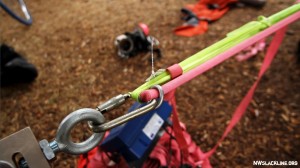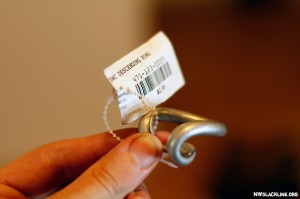Break test: non-forged aluminum line locker
If you’ve spent any amount of time on this site you probably know I am a fan of line-lockers. They keep the webbing flat, protect it reasonably well, and for nylon webbing typically ensure about 95% of rated strength (instead of the 50 or 65% that a knot might). The first line lockers (that I know of) were pieces of steel chain link, and this worked well except for the weld on the link, which could cause a burr on the line. Some people file the weld off. Sometime in 2008 or so, rappel rings began to find popularity as line-lockers. I still use them exclusively when it comes to short line attachment. For longlines and highlines I use sleeved shackle-based line-lockers or a slack-banana style device, but that is another post (coming soon!). If you don’t know what a line-locker is, or how to use one, see this earlier post.For the line lockers I own, some are a few years old, and covered in ‘dings’ but still in good shape. Why is this? Because they are forged aluminum. I use only steel line lockers, or forged aluminum. Sometimes I meet people in parks, or at the beach, and they want to know about my rigging. Often they ask about my line lockers, and I show them how they work, and they usually agree the locker method is quite elegant. I explain where to buy them, and to be certain to buy a forged one with a 20kN rating stamped on it.
 Occasionally I see these people later, and occasionally some of them have a non-forged locker. This might be because REI was out of stock of the Omega Pacific rappel rings they sell, or it might simply be because they were cheap and wanted to save a dollar. Either way, it is NOT SAFE to use a non-forged alumimum descending ring as a line-locker. They were not meant for this, and the deformation strength is too low. This is obvious to me just by looking at the ring, and especially by holding it (it weighs maybe a few grams).
Occasionally I see these people later, and occasionally some of them have a non-forged locker. This might be because REI was out of stock of the Omega Pacific rappel rings they sell, or it might simply be because they were cheap and wanted to save a dollar. Either way, it is NOT SAFE to use a non-forged alumimum descending ring as a line-locker. They were not meant for this, and the deformation strength is too low. This is obvious to me just by looking at the ring, and especially by holding it (it weighs maybe a few grams).
I was at REI the other day, helping a friend build a slackline setup, and when they were out of the Omega rings, an employee there told her that the SMC ring would be safe. I told him it wasn’t. He said he uses it all the time in his slackline. I decided it was time to do a test.
If you watch the video below, you’ll see that the ring begins to deform at around 1200lbs of tension. Keep in mind, this is a brand new ring (with the tag still on it!). That is way too low of a number. Leaving aside the fact that I often tension a line to over 1000lbs by myself, without the use of a pulley system, it shouldn’t take much imagination to see how a line at even 500 or 600lbs could cause the ring to fatigue by way of repeated riggings and occasional jumps, bounces, surfings, and so forth.
 By 2500lbs the ring is severely deforming, beginning to wrap around the steel Omega Pacific carabiner we used. At 2800lbs the webbing we used blows, which is probably all that kept this ring from deforming any further. This was suspected to be defective webbing (part of why we were using it). Had we used Type18 webbing, the ring would have become more of a pretzel before finally snapping into fragments.
By 2500lbs the ring is severely deforming, beginning to wrap around the steel Omega Pacific carabiner we used. At 2800lbs the webbing we used blows, which is probably all that kept this ring from deforming any further. This was suspected to be defective webbing (part of why we were using it). Had we used Type18 webbing, the ring would have become more of a pretzel before finally snapping into fragments.
Will you ever put 2500lbs of tension onto this (or any?) line-locker? Probably not. But I can see how the locker could become very fatigued through just repeated riggings that might see 700 or 1000lbs of peak tension. Not a good idea.
Bottom line: don’t use aluminum lockers unless they are forged and rated for 20kN or better. Also, I don’t advise using SMC’s cylindrical forged lockers unless you use a sleeve or other spacer. Saving one dollar on not buying a forged ring is in no way worth the risk of something blowing out explosively.
My safety motto: overbuild your system, inspect your gear, don’t do dumb things.
UPDATE (May 14, 2012): I met a guy at the park who had just learned to slackline, and had rigged only twice on his SMC ring. I took a photo of it with my phone. You can see already it is noticeably warped. Don’t use these rings for slacklining.

No comments yet... Be the first to leave a reply!